LOWER BEAK
We examined three beaks of E. famelica from individuals (115, 140, 190 mm ML). The following characters are taken from Clarke (1986). Arithmetic means from the three squid are used for characters requiring measurements.
- Pigmentation - Normal.
- Pigmentation pattern - See photographs.
- (Wing length)/(visible rostral edge) (profile) - 2.0
- Height/baseline (profile) - 1.01
- (Length from rostral tip to wing tip projected on baseline)/baseline (profile) - 0.26
- (Hood length)/(crest length) (profile) - 0.58
- (Crest length)/baseline (profile) - 0.56
- (Rostral base)/(visible rostral edge) (profile) - 1.04
- (Hood length)/(visible rostral edge) (profile) - 0.81
- Rostral width ratio [LRL/(length between jaw angles)] - 2.23
- Wing angle (= visible jaw angle in profile) - Obtuse.
- Shape of jaw edge - Straight, or nearly straight, proximally with strong curve distally.
- Rostrum (profile) - Unusually slender taper to very pointed tip.
- Hood distance from crest - Normal .
- Crest - Often slightly curved.
- Lateral wall notch - Normal.
- Hood-wing - Narrows slightly at wing.
- Hood notch - Shallow.
- Lateral walls to free corner - Well separated with increasing but low divergence from one another.
- Hood midline - Moderately curved.
- Hood surface without prominent longitudinal ridges or grooves.
- Wing fold - Moderate, angled, with groove between wing fold and shoulder blade.
- Shoulder blades - Shoulder blades moderate, oral edges project evenly from shoulder.
- Shoulder cartilage - Shoulder cartilage virtually absent by 115 mm ML.
- Jaw angle - Obtuse.
- Jaw edge extension without step and with prominent angle point extending well past shoulder padding.
- Jaw edge in cross-section - Blunt.
- Crest in cross-section - Narrow.
- Lateral wall - Lateral-wall fold with a solid, tall ridge that forms a slender fin that slightly overhangs its base anteriorly, ridge nearly reaches posterior edge of lateral wall; lateral wall fold with sharp medial groove and short, steep-sloping sides.

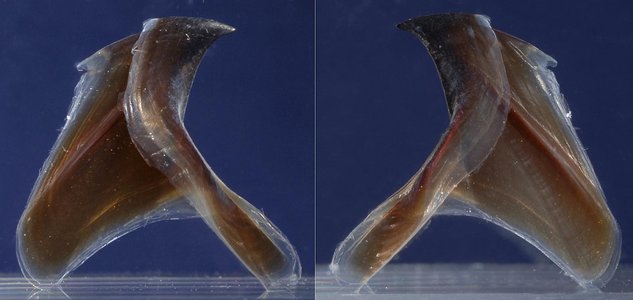
Figure. Left and right side views of the same lower beak of E. famelica, 140 mm ML, 4.9 mm LRL, immature female, Hawaiian waters. Photographs by R. Young.


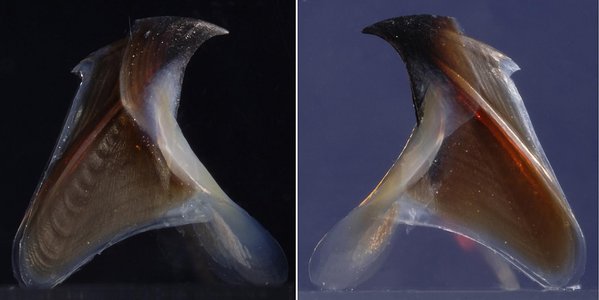
Figure. Left and right side views of the same lower beak of E. famelica, 115 mm ML, 3.8 mm LRL, immature female, Hawaiian waters. Photographs by R. Young.

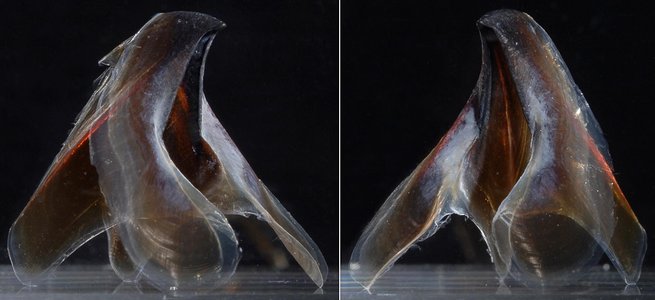
Figure. Left and right side-oblique views of the same lower beak of E. famelica, 140 mm ML, immature female, Hawaiian waters. Photographs by R. Young.

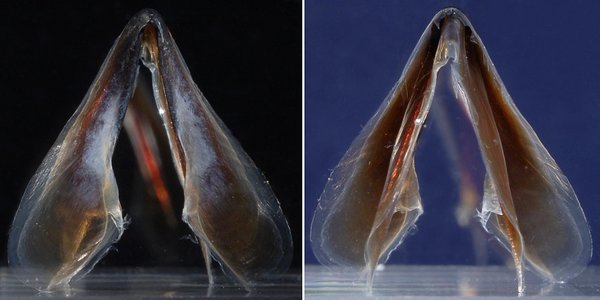
Figure. Front (left) and rear (right) views of the same lower beak of E. famelica, 140 mm ML, immature female, Hawaiian waters. Photographs by R. Young.

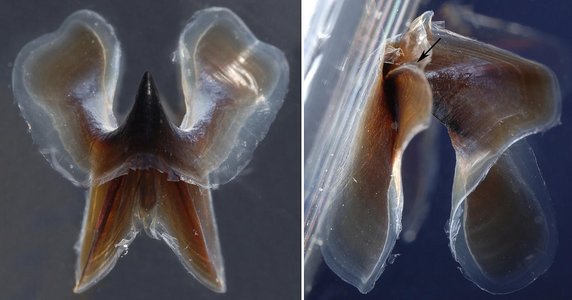
Figure. Two views of the lower beak of E. famelica, 140 mm ML, immature female, Hawaiian waters, showing the width of the lateral wall ridge (arrow). Left - Top view. Right - Photographs by R. Young.

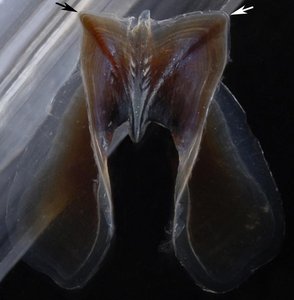
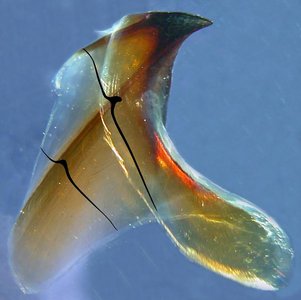
Figure. Various views of the lower beak of E. famelica. Left - Posterior view, 140 mm ML, showing the deep grooves (arrows) on the medial sides of the lateral walls that are associated with the lateral wall ridges of the opposite sides. Right - Side view of a beak of E. famelica, 190 mm ML, 4.5 mm LRL, that has been cut in half and laid flat with drawn cross-sections of the lateral wall overlayed where the cuts occurred.
Comments
E. famelica lower beaks are very similar to those of E. atlantica and the few beaks we have examined are insufficient to determine if they can be separated. However, E. famelica (like E. atlantica can be most easily separated from other slender-beaked mastigoteuthids (ie, Mastigopsis hjorti and Mastigotragus pyrodes) by their slender, curving rostral tip (profile), the fin-like shape of the lateral wall ridge and the obtuse jaw angle. The shoulder blade has the same rhomboidal shape as in Mastigopsis hjorti but is relatively much smaller while the shoulder blade of Mastigotragus pyrodes is more narrow and trapezoidal in shape. The projecting edge of the shoulder blade roughly parallels the shoulder in E. famelica while in the other two species the distal end tends to project more.
UPPER BEAK


Figure. Side views of the upper beaks of E. famelica, Hawaiian waters. Left - 140 mm ML, immature female. Right - 115 mm ML, immature female. Photographs by R. Young.

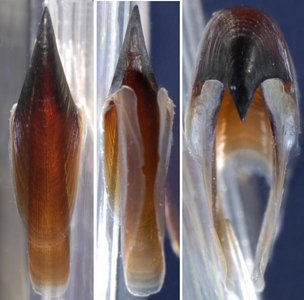
Figure. Various views of the upper beak of E. famelica, 140 mm ML, immature female, Hawaiian waters. Left - Top view. Middle - Bottom view. Right - Front view. Photographs by R. Young.
Comments
To be added.




 Go to quick links
Go to quick search
Go to navigation for this section of the ToL site
Go to detailed links for the ToL site
Go to quick links
Go to quick search
Go to navigation for this section of the ToL site
Go to detailed links for the ToL site